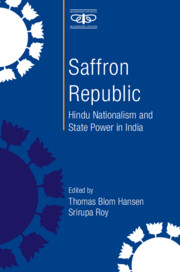8 - ‘Mitakuye Oyasin – We Are All Related:’ Hindutva and Indigeneity in Northeast India
Published online by Cambridge University Press: 31 May 2022
Summary
Introduction
On 5 August 2020, Prime Minister Narendra Modi laid the foundation for the controversial Ram Temple in Ayodhya by performing bhumi puja (groundbreaking ceremony) amid a massive surge of coronavirus cases. According to various media accounts, soil and water were collected from different pilgrimage sites, which Lord Ram allegedly visited, unifying India through a sacred geography of myth and ritual (North East Now 2020). Members of the Rashtriya Swayamsevak Sangh (RSS) and the Dolloi, village chief of Jowai, Meghalaya collected soil and water from the River Myntdu according to the ritual of the indigenous Niamtre faith (Manosh 2020). Myntdu is not only a river sacred to the indigenous people, but it is also the place where the Jaintia rebellion started against the British led by U Kiang Nangbah (Manosh 2020).
According to the RSS pracharak Gaurav Tiwari, the Niamtre people of Meghalaya worship ‘Ram and Lakhan (Lakshman)’. Since time immemorial, they naturalise the region's long mythological connection to Bharat (India) that includes Rukmini (allegedly from Arunachal Pradesh), Krishna's consort, and other figures from the Mahabharata (Longkumer 2020). The RSS believes soil and water to be integral elements upon which identities and histories are materialised. Varied responses were aired on Facebook about how this act of collecting soil and water plays on the larger Hindutva idea of cultural appropriation on the one hand and the argument that all indigenous faiths are, in some way, a part of the larger Hindu cultural and religious universe on the other. The natural features (mountains, rivers, soil, and land), places of pilgrimage, and ritual spaces act as material evidence that ground the Northeast to Bharatvarsh through ‘earth’ (bhumi). In fact, a Vivekananda Kendra worker in Arunachal Pradesh, Narendra Joshi (2000, 7), draws on V. D. Savarkar's notion of Hindutva to establish these connections:
After all we can hide or destroy papers, stones, paintings or pothis, but we cannot hide the Himalayas, we cannot destroy Kailasa, Manasarovar and mighty rivers originating from there. Those divine mothers are originating from the same place, innocent of the political boundaries and the associated heinous divisions they have to witness as they come down to the ground realities. But even now, with all our great ‘achievements’, we may perhaps negate the history [but] we cannot negate the geography of this region. (Emphasis added)
- Type
- Chapter
- Information
- Saffron RepublicHindu Nationalism and State Power in India, pp. 181 - 198Publisher: Cambridge University PressPrint publication year: 2022

